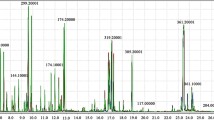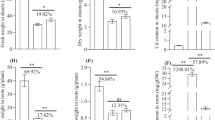Abstract
Chromium (Cr) pollution in farmlands is a common environmental issue, that can seriously inhibit plant growth, damage plant cells, and even cause plant death. In this study, bok choy (Brassica campestris L. ssp. chinensis Makino (var. communis Tsen et Lee)) was selected as a model plant to investigate the metabolic response to Cr stress at concentrations of 2.0 mg/L and 8.0 mg/L. Metabolites were identified using gas chromatography-mass spectrometry. Principal component analysis and orthogonal projections to latent structure discriminant analysis revealed the notable effect of Cr stress on the metabolites of bok choy. Under Cr stress, 145 metabolites were identified in the bok choy leaves. At 2.0 mg/L Cr stress, 10 and 26 metabolites changed compared to the control after 7 d and 14 d, respectively. At 8.0 mg/L Cr stress, 24 and 24 metabolites changed significantly after 7 and 14 d, respectively. The data showed that metabolism was affected by the Cr stress concentration and exposure time. Specifically, under the Cr stress, the tricarboxylic acid cycle, glutamine synthetase/glutamate synthase cycle, and partial amino acid metabolic pathways were blocked, inhibiting the normal growth and development of bok choy. The change of citric acid content was the most significant, and the accumulation of citric acid indicated the degree of plant Cr toxicity and resistance. These results would facilitate further dissection of the mechanisms of heavy metal accumulation/tolerance in plants and the effective management of such contamination in vegetable crops by genetic manipulation.




Similar content being viewed by others
References
Adrees M, Ali S, Iqbal M, Bharwana SA, Siddiqi Z, Farid M, Ali QSaeed R, Rizwan M (2015) Mannitol alleviates chromium toxicity in wheat plants in relation to growth, yield, stimulation of anti-oxidative enzymes, oxidative stress and Cr uptake in sand and soil media Ecotoxicol Environ Saf 122:1–8
Aguiar-pulido V, Huang W, Suarez-ulloa V, Cickovski T, Mathee K, Narasimhan G (2016) Approaches for microbiome analysis Evol Bioinforma 12(S1):5–16
Ahmad P, Alyemeni MN, Ahanger MA, Egamberdieva D, Wijaya L, Alam P (2018) Salicylic acid (SA) induced alterations in growth, biochemical attributes and antioxidant enzyme activity in faba bean (Vicia faba L.) seedlings under NaCl toxicity Russ J Plant Physiol 65:104–114
Bailey NJC, Oven M, Holmes E, Nicholson JK, Zenk MH (2003) Metabolomic analysis of the consequences of cadmium exposure in Silenecucubalus cell culturesvia1H – NMR spectroscopy and chemometrics Phytochem 62(6):851–858
Chen HL, Arocena JM, Li JB, Thring RW, Zhou JM (2014) Assessments of chromium (and other metals) in vegetables and potential bio-accumulations in humans living in areas affected by tannery waste. Chemosphere 112:412–419
Choudhury S, Panda SK (2005) Toxic effects, oxidative stress and ultrastructural changes in moss Taxithelium nepalense (schwaegr.) broth.under chromium and lead phytotoxicity Water Air Soil Pollut 167(1-4):73–90
Ganesh KS, Baskaran L, Rajasekaran S, Sumathi K, Chidambaram ALA, Sundaramoorthy P (2008) Chromium stress induced alterations in biochemical and enzyme metabolism in aquatic and terrestrial plants Colloids Surf B Biointerfaces 63:159–163
Ghatak A, Chaturvedi P, Weckwerth W (2018) Metabolomics in plant stress physiology. Adv Biochem Eng Biotechnol 164:187–236
Gu YJ, Wu ZX (2012) Application of metabolomics in research of plants. Guangdong Agric Sci 39(4):105–107
Guo R, Shi LX, Yang CW, Yan CR, Zhong XL, Liu Q, Xia X, Li HR (2016) Comparison of ionomic and metabolites response under alkali stress in old and young leaves of cotton (Gossypium hirsutum L.) seedlings. Plant Sci 7(5):1–9
He Y, Dai SJ, Dufresne CP, Zhu N, Pang QY, Chen SX (2013) Integrated proteomics and metabolomics of Arabidopsis acclimation to gene-dosage dependent perturbation of isopropylmalate dehydrogenases. PLoS ONE 8:e57118. https://doi.org/10.1371/journal.pone.0057118
Jalmi SK, Bhagat PK, Verma D, Noryang S, Tayyeba S, Singh K, Sharma D, Sinha AK (2018) Traversing the links between heavy metal stress and plant signaling Front Plant Sci 9:12. https://doi.org/10.3389/fpls.2018.00012
Liu GN, Yu YJ, Hou J, Xue W, Liu XH, Liu YZ, Wang WH, Alsaedi A, Hayat T, Liu ZT (2014) An ecological risk assessment of heavy metal pollution of the agricultural ecosystem near a lead-acid battery factory. Ecol Indic 47:210–218
Ma ZL, Li Y, Ye C, Lin XY, Wei CB (2018) The influence of farmland pollution on the quality and safety of agricultural products. IOP Conf Ser Earth Environ Sci 113(1):012114
Nagarajan M, Ganesh KS (2013) Effect of chromium on growth, biochemicals and nutrient accumulation of paddy (Oryza sativa L.). Int Lett Nat Sci 23:63–71
Nickens KP, Patierno SR, Ceryak S (2010) Chromium genotoxicity: a double-edged sword. Chem Biol Interact 188(2):76–88.
Panda SK (2007) Chromium-mediated oxidative stress and ultrastructural changes in root cells of developing rice seedlings. J Plant Physiol 164:1419–1428
Phang TH, Shao G, Lam HM(2018) Salt tolerance in soybean. J Integr Plant Biol 50(10):1196–1212
Scalabrin E, Radaelli M, Capodaglio G (2016) Simultaneous determination of shikimic acid, salicylic acid and jasmonic acid in wild and transgenic Nicotiana langsdorffii plants exposed to abiotic stresses. Plant Physiol Biochem 103:53–60
Scoccianti V, Bucchini AE, Iacobucci M, Ruiz KB, Biondi S (2016) Oxidative stress and antioxidant responses to increasing concentrations of trivalent chromium in the Andean crop species Chenopodium quinoa Willd. Ecotoxicol Environ Saf 133:25–35
Shahid M, Shamshad S, Rafiq M, Khalid S, Bibi I, Niazi NK, Dumat C, Rashid MI (2017) Chromium speciation, bioavailability, uptake, toxicity and detoxification in soil-plant system: a review. Chemosphere 178:513–533
Sharma A, Kapoor D, Wang J, Shahzad B, Kumar V, Bali AS, Jasrotia S, Zheng B, Yuan H, Yan D (2020) Chromium bioaccumulation and its impacts on plants: an overview. Plants 9:100. https://doi.org/10.3390/plants9010100
Sharma DC, Sharma CP, Tripathi RD (2003) Phytotoxic lesions of chromium in maize. Chemosphere 51(1):63–68
Singh HP, Mahajan P, Kaur S, Batish DR, Kohli RK (2013) Chromium toxicity and tolerance in plants. Environ Chem Lett 11(3):229–254
Sinha V, Pakshirajan K, Chaturvedi R (2018) Chromium tolerance, bioaccumulation and localization in plants: an overview. J of Environ Manage 206:715–730
Stambulska UY, Bayliak MM, Lushchak VI, 2018. Chromium(VI) toxicity in legume plants: modulation effects of rhizobial symbiosis. Biomed Res Int. https://doi.org/10.1155/2018/8031213
Usadel B, Blasing OE, Gibon Y, Poree F, Hohne M, Gunter M, Trethewey R, Kamlage B, Poorter H, Stitt M (2008) Multilevel genomic analysis of the response of transcripts, enzyme activities and metabolites in Arabidopsis rosettes to a progressive of temperature in the non-freezing range. Plant Cell Environ 31(4):518–547
Wang XL, Zhang XX, Chen J, Wang X, Cai J, Zhou Q, Dai TB, Cao WX, Jiang D (2018) Parental drought-priming enhances tolerance to post-anthesis drought in offspring of wheat Front Plant Sci 9:261
Wu DZ, Shen QF, Cai SG, Chen ZH, Dai F, Zhang GP (2013) Ionomic responses and correlations between elements and metabolites under salt stress in wild and cultivated barley. Plant Cell Physiol 15(12):1976–1988
Zhang N, Fang Z, Zhang R (2017) Comparison of several amendments for in-site remediating chromium-contaminated farmland soil Water Air Soil Pollut 228(10):400. https://doi.org/10.1007/s11270-017-3571
Zhu GT, Gou JB, Klee H, Huang SW (2019) Next-gen approaches to flavor-related metabolism. Annu Rev Plant Biol 70:187–212
Funding
This study was funded by Zhejiang Natural Science Foundation of China (ZJNSF, Project No. LY17D010003), Science and Technology Department of Zhejiang Province (Project No. 2019C54002), and Wenzhou Science and Technology Bureau (Project No. S20160002).
Author contributions
JZ and YT conceptualized and planned the framework. JW, SW, YL, and QZ have carried out the mentioned experiments and collected the literature. YW and LL drafted the manuscript. HC planned the framework and made the final version of the manuscript. All the authors read and approve the final manuscript.
Author information
Authors and Affiliations
Corresponding author
Ethics declarations
Conflict of interest
The authors declare that they have no conflict of interest.
Ethical approval
The research article ensures objectivity and transparency in research and secures that accepted principles of ethical and professional conduct have been followed. This original research article does not contain any studies with human participants and animals performed by any of the authors.
Informed consent
Informed consent was obtained from all individual participants included in the study.
Additional information
Publisher’s note Springer Nature remains neutral with regard to jurisdictional claims in published maps and institutional affiliations.
Rights and permissions
About this article
Cite this article
Zhou, J., Wang, J., Tao, Y. et al. Metabolic response of bok choy leaves under chromium pollution stress. Ecotoxicology 30, 231–239 (2021). https://doi.org/10.1007/s10646-020-02344-8
Accepted:
Published:
Issue Date:
DOI: https://doi.org/10.1007/s10646-020-02344-8




